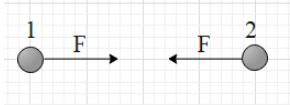
The height at which the weight of a body becomes $\dfrac{1}{16}th$ of its weight on the surface of earth (radius R) is
A. $3R$
B. $4R$
C. $5R$
D. $15R$
Answer
557.1k+ views
Hint: Weight of a body is the gravitational force by which it is attracted by another body of massive mass (earth). Use the formula for the gravitational force between two bodies and find the required height by comparing the weights at the two places.
Complete step by step answer:
Let us first understand what is meant by the weight of a body. Weight of a body is the gravitational force by which it is attracted by another body of massive mass. In this case, the body of massive mass is earth. If two bodies of masses ${{m}_{1}}$ and ${{m}_{2}}$ are apart from each other than the gravitational force between the two is given as $F=\dfrac{G{{m}_{1}}{{m}_{2}}}{{{d}^{2}}}$, where G is the universal gravitational constant.
Let the mass of earth be $M$ and the mass of the body be $m$. Therefore, the gravitational force by which the earth attracts the body when it is at a distance d from the centre of the earth is equal to $F=\dfrac{GMm}{{{d}^{2}}}$ …. (i).
Hence, the weight of the body is $F=\dfrac{GMm}{{{d}^{2}}}$.
When the body is on the surface of earth, $d=R$ (radius of earth).
Therefore, the weight of the body on the surface of the earth is equal to ${{F}_{s}}=\dfrac{GMm}{{{R}^{2}}}$ … (ii).
Let us now find the value of d for which the weight is $\dfrac{1}{16}th$ of the body’s weight on the surface of earth.
For this, substitute $F=\dfrac{{{F}_{s}}}{16}$ in (i).
$\Rightarrow \dfrac{{{F}_{s}}}{16}=\dfrac{GMm}{{{d}^{2}}}$
Now, substitute the value of ${{F}_{s}}$ from (ii).
$\Rightarrow \dfrac{\dfrac{GMm}{{{R}^{2}}}}{16}=\dfrac{GMm}{{{d}^{2}}}$
$\Rightarrow \dfrac{1}{16{{R}^{2}}}=\dfrac{1}{{{d}^{2}}}$
$\Rightarrow {{d}^{2}}=16{{R}^{2}}$
$\therefore d=\pm 4R$.
However, the value $d=-4R$ is discarded because distance cannot be negative.Hence, $d=4R$.But, $d=4R$ is the distance between the centre of the earth and the body. The height of the body from the surface of earth will be $d-R=4R-R=3R$.Therefore, the height at which the body’s weight is $\dfrac{1}{16}th$ of the weight on the surface of earth is $3R$.
Hence, option A is the correct answer.
Note:The gravity is an action-reaction type force. This means that if the earth attracts the body with a gravitational force of some magnitude, then the body also attracts the earth towards itself with the same magnitude.

As you can see in the figure, the magnitude of the force exerted by a 1 on 2 is equal to the magnitude of the force exerted on 2 by 1. But the directions of the two forces are opposite.
Complete step by step answer:
Let us first understand what is meant by the weight of a body. Weight of a body is the gravitational force by which it is attracted by another body of massive mass. In this case, the body of massive mass is earth. If two bodies of masses ${{m}_{1}}$ and ${{m}_{2}}$ are apart from each other than the gravitational force between the two is given as $F=\dfrac{G{{m}_{1}}{{m}_{2}}}{{{d}^{2}}}$, where G is the universal gravitational constant.
Let the mass of earth be $M$ and the mass of the body be $m$. Therefore, the gravitational force by which the earth attracts the body when it is at a distance d from the centre of the earth is equal to $F=\dfrac{GMm}{{{d}^{2}}}$ …. (i).
Hence, the weight of the body is $F=\dfrac{GMm}{{{d}^{2}}}$.
When the body is on the surface of earth, $d=R$ (radius of earth).
Therefore, the weight of the body on the surface of the earth is equal to ${{F}_{s}}=\dfrac{GMm}{{{R}^{2}}}$ … (ii).
Let us now find the value of d for which the weight is $\dfrac{1}{16}th$ of the body’s weight on the surface of earth.
For this, substitute $F=\dfrac{{{F}_{s}}}{16}$ in (i).
$\Rightarrow \dfrac{{{F}_{s}}}{16}=\dfrac{GMm}{{{d}^{2}}}$
Now, substitute the value of ${{F}_{s}}$ from (ii).
$\Rightarrow \dfrac{\dfrac{GMm}{{{R}^{2}}}}{16}=\dfrac{GMm}{{{d}^{2}}}$
$\Rightarrow \dfrac{1}{16{{R}^{2}}}=\dfrac{1}{{{d}^{2}}}$
$\Rightarrow {{d}^{2}}=16{{R}^{2}}$
$\therefore d=\pm 4R$.
However, the value $d=-4R$ is discarded because distance cannot be negative.Hence, $d=4R$.But, $d=4R$ is the distance between the centre of the earth and the body. The height of the body from the surface of earth will be $d-R=4R-R=3R$.Therefore, the height at which the body’s weight is $\dfrac{1}{16}th$ of the weight on the surface of earth is $3R$.
Hence, option A is the correct answer.
Note:The gravity is an action-reaction type force. This means that if the earth attracts the body with a gravitational force of some magnitude, then the body also attracts the earth towards itself with the same magnitude.

As you can see in the figure, the magnitude of the force exerted by a 1 on 2 is equal to the magnitude of the force exerted on 2 by 1. But the directions of the two forces are opposite.
Recently Updated Pages
Master Class 11 Economics: Engaging Questions & Answers for Success

Master Class 11 English: Engaging Questions & Answers for Success

Master Class 11 Social Science: Engaging Questions & Answers for Success

Master Class 11 Biology: Engaging Questions & Answers for Success

Class 11 Question and Answer - Your Ultimate Solutions Guide

Master Class 11 Business Studies: Engaging Questions & Answers for Success

Trending doubts
10 examples of friction in our daily life

One Metric ton is equal to kg A 10000 B 1000 C 100 class 11 physics CBSE

Difference Between Prokaryotic Cells and Eukaryotic Cells

1 Quintal is equal to a 110 kg b 10 kg c 100kg d 1000 class 11 physics CBSE

Explain zero factorial class 11 maths CBSE

What is a periderm How does periderm formation take class 11 biology CBSE




